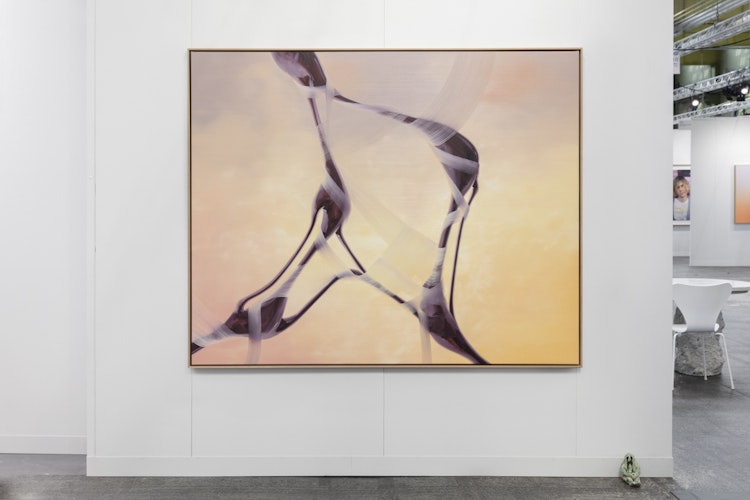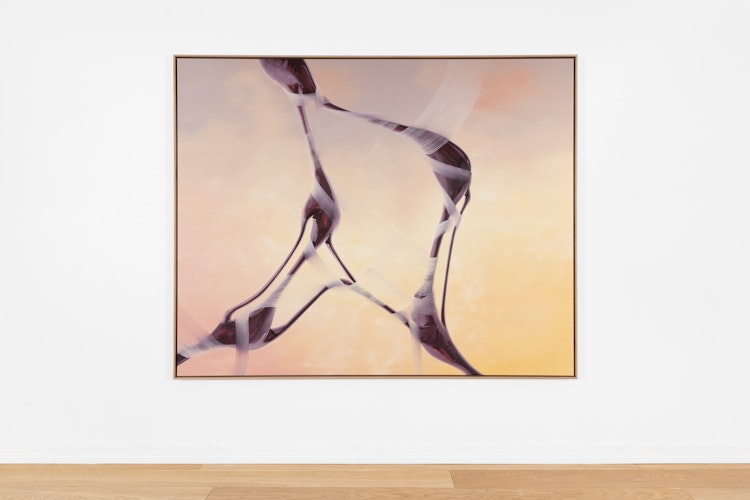10 questions with Lars Morell


On the occasion of the new edition of Enter Art Fair in Copenhagen, we asked Lars Morell, one of the artists on view, 10 questions regarding his work, career, inspirations, and the story behind his new artworks exhibited at Enter.

Lars Morell (b. 1980, NO) is educated at the Oslo National Academy of Fine Arts.
Over the past few years, Lars Morell has created a complex and diverse body of work consisting of photographs, sculptures, and installations. Morell’s work has always encompassed and questioned the visible/invisible and what seems to be something that it is not. In numerous exhibitions nationally and internationally this iconography has been thoroughly developed, and in his recent works distorted shapes, which now “grow” over the canvas, are constructed from imagery in his previous works – paintings, sculptures and drawings. We see colored constructs that at first glance are reminiscent of branching root systems; we recognize the outlines of chains and hooks – and thus again objects that are used in illusion and deception. Morell develops these works out of figuration and sees them as distorted still lives, as a dilemma between abstraction and representational painting.
Morells works is in numerous private collections as well as the Caviar Factory Art Museum, Malmö Art Museum, Sørlandet Art Museum, Equinor and KLP.
Here are his words.
/1
QB: Do you remember your very first approach to art? What did you find fascinating about it?
LM: Not at a specific point in time, but I remember that I early on got the taste of the "bubble" or the “state” that occurs when I zoom in on the work. Lost in translation, sort of. Like an enjoyment of the process first and foremost. Many hours in the boys' room experimenting. And then gradually there was also some rumination regarding genres, techniques and figurative languages. It wasn't like a switch being turned on, but more like a slowly increasing interest. The experience that there was something more I was curious about and a code that could be cracked in so many ways. The wonder for ambiguity is still present. I was also fascinated by how some things were accepted into museums while others were overlooked. There was also the fact that I didn't settle on what I was going to do with my life. So the slightly wilful thought of actually choosing a direction that clearly has a high risk of collapse never left me - and it's the one that still gets me out of bed every day. I still have the euphoria from the bubble of focus, but it feels more necessary and acute to focus on the work now than when I started.
/2
QB: What has influenced you the most in your career? How has this changed over time?
LM: The places I've been and the people around me. The period in Paris in 2011 - 2012 was significant, I got some fruitful opportunities there. The exhibition at the Palais de Tokyo was a definite turning point. Instead of a source of influence, I think of it more as a cacophony, or a symphony of experience. The resonance depends on whether one manages to piece it together or see the contours of the direction it's heading.
In terms of daily inspiration, it doesn't have to be the big things. I take great pleasure in looking at art, and the anticipation that I might get a rare thrill "this time" is worth the trip. Increasingly, I also find myself getting excited about everyday things, like how the light hits the cake display while I stand in line for a coffee. Perhaps this appeals to the southern part of me, kind of like Markus from “Kilden” by Gabriel Scott, who values the small things while pondering over the big ones.
/3
QB: What do you think the role of an artist is in today’s society?
LM: A meeting point that can lead in all directions, and all the drama that unfolds on the way to and from.

/4
QB: How would you describe your own artistic expression?
LM: A kind of logbook where light, composition and palette are the ingredients for a dish served to those with a keen eye. Energy, tension, balance and momentum described with colours and compositions. Individual notes (works) that hopefully, over time, form the larger context.
In an attempt to see things from the outside, I’m preoccupied with the unconscious. How visual memory and perception lead to such different readings. I don't want to push the viewer in a specific direction, but rather create the opportunity for a subjective journey inward.
/5
QB: From idea to finished artwork, how are your artworks made? Do you follow a particular process or “ritual”?
LM: To some extent, I have a consistent ritual were I work at fixed times and mostly follow the same approach to each image. Since the process requires full focus and is physically demanding, I have limited myself to work "regular" working days for about 7 hours, give or take. Beyond this, I become less focused and it rarely ends well.
The approach is the same for each image, but presents equally significant challenges every time. A loose composition is sketched out, then I refine it and mask it with tape. Then I paint the background and then remove the masking tape. Finally, I fill in the foreground and tie it all together with light strokes that resemble silk ribbons. Each image follows the same process, but composition, temperature, mixing ratio, pigments and oil all contribute to something new happening every time. Choices must be made or eliminated along the way. Much of the challenge and motivation comes from my own mix of patience and restlessness. Each image needs both meditative reflection and immediate, almost hasty decisions. The process is twofold: planning and improvisation. Through trial and error, I’ve found that an equal mix of planning and improvisation yields, in my view, the most successful results.
/6
QB: Early in your career, we can see a number of sculptural works and installations that appear more figurative than abstract. In recent years, however, your works appear more abstract than figurative, especially in the "Shadow Canvas” series. How and why did this transition happen?
LM: I used to compose clearer compositions and narratives. A more staged mindset about how the gallery space could be used and experienced act by act. Now I'm more aware that what works there, must also work piece by piece as individual works on people’s walls at home.
Even though I'm not very conscious of this transition in my work, I think the boundary between figuration/abstraction has the potential to balance somewhere between the obviously banal and the subtly seductive. It can be the entrance to the viewer's reading. In the series "Shadow Canvas”, the point was precisely to blur or obscure the boundary between the figurative and the abstract.
Mostly, I envision a visual goal, with some partially formulated, and then I try to move in that direction to discover what challenges it presents. The direction is winding rather than conceptually clear. Subtle implications rather than explicit ones. I strive for (in my own work) and prefer other’s work that bears traces of choices made along the way with energy, ingenuity and a nerve - rather than a desire to clearly and distinctly place a finished project on the shelf of art history.

/7
QB: Whereas the series "Shadow Canvas" appears abstract, your latest series "Translations" moves more in the intersection between abstract and figurative painting, where the forms that previously appeared as shadows are now perceived as the contours of something. Where do these shapes come from? Do they arise from your imagination or from memories?
LM: After working through a large number of variations in the "Shadow Canvas" series, I wanted to approach the compositions differently. When I brought the soft forms in the “Shadow paintings” to the foreground in the “Translations” compositions, I needed to abstract them in a different way. What was previously only glimpsed became completely clear and lost its function. I was then forced to add a form of abstraction to retain the ambiguity and openness of the images. Originally, the shapes in the shadow paintings were intended as actual shadows that could have appeared on someone's windowsill or out in nature. In this way, I consider them as abstracted still lives. In "Translations", I see still life as something in a broader sense. It's more like a section of something larger with less recognisable shapes and purer compositions. Balance, momentum and movement which together create a kind of mood or inner landscape, if you will.
They clearly relate to memories, but without imagination, abstraction is difficult. Let me quote Jens Fänge here:
"If I had all the answers I would stop painting and be driving a bus or something"
Jens Fänge ("Alcove" - Perrotin, New York, 2019)
/8
QB: Throughout your artistry, your expression has developed organically over time and medium. We can start with your sculptures, which evolved into shadow paintings, and then took shape and substance from shadows to more concrete forms. Do you have an idea of how this will further develop?
LM: I'm just as curious about that as you are! It's a kind of choreography. I understand the process, but I don't control it. Step by step with trial and error. I have periods where I work within a series and continue with it until I feel most of it has been tried out before moving on to a new one. It’s a daily dance that takes place, not just before each exhibition - but all the time. I trust the platform of experience I stand on and actively use my intuition. It’s a constant flow of choices that I want to make on instinct as much as possible, in my view, these choices make the most sense.
As Tal R said in an interview with Elephant: "Ask any boxer to explain first, and he is going to have a very broken nose - the same goes for artists."
/9
QB: Can you tell us a bit about the artworks by you on view at Enter Art Fair 2023?
LM: I struggled a lot with these images, and after many attempts, it finally clicked. They were challenging to make, but at the same time it seemed like I took a step further with these particular compositions. To a certain extent, the images provide a glimpse into the months before summer. They are translations of the mood, the choreography of early summer with soundtracks from Emilie Nicolas, Undergrunn, Kalabrese and Stimmung. Early mornings at the gym, a few trips to the tennis court, summer coffee from Kaffebrenneriet, and a few meetings about a commissioned sculpture that will stand in a garden.
/10
QB: Final question: If you were to have dinner with five other artists, alive or not, who would you choose?
LM: Now that we're in Denmark, I'm advocating for a bright summer evening with Anna Ancher, P.S. Krøyer, Carl Locher, Kitty Kielland and Amaldus Nielsen.
If this had been twenty years ago, I would probably be at a pub with Urs Fischer, Jason Rhoades, Glenn Brown, Jordan Wolfson and Matthew Barney.
What are you looking for?